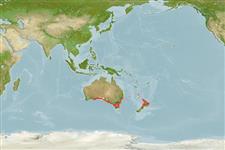>
Acropomatiformes (Oceanic basses) >
Pentacerotidae (Armorheads) > Histiopterinae
Etymology: Paristiopterus: Greek, pareia = jaw + Greek, istion = sail + Greek, pteron = wing, fin (Ref. 45335).
More on author: Günther.
Environment: milieu / climate zone / depth range / distribution range
Écologie
marin démersal; profondeur 20 - 170 m (Ref. 9563). Temperate; 26°S - 45°S, 123°E - 179°E
Eastern Indian Ocean: southern Australia, from South Australia to New South Wales. Southwest Pacific: New Zealand (Ref. 5755).
Taille / Poids / Âge
Maturity: Lm ? range ? - ? cm
Max length : 100.0 cm TL mâle / non sexé; (Ref. 4537)
Recorded from the continental shelf (Ref. 9563). Feeds mainly on benthic organisms (Ref. 26966).
Life cycle and mating behavior
Maturité | Reproduction | Frai | Œufs | Fécondité | Larves
Robins, C.R., R.M. Bailey, C.E. Bond, J.R. Brooker, E.A. Lachner, R.N. Lea and W.B. Scott, 1991. World fishes important to North Americans. Exclusive of species from the continental waters of the United States and Canada. Am. Fish. Soc. Spec. Publ. (21):243 p. (Ref. 4537)
Statut dans la liste rouge de l'IUCN (Ref. 130435: Version 2024-2)
Menace pour l'homme
Harmless
Utilisations par l'homme
Pêcheries: commercial
Outils
Articles particuliers
Télécharger en XML
Sources Internet
Estimates based on models
Preferred temperature (Ref.
123201): 14 - 18.1, mean 15.9 °C (based on 143 cells).
Phylogenetic diversity index (Ref.
82804): PD
50 = 0.7501 [Uniqueness, from 0.5 = low to 2.0 = high].
Bayesian length-weight: a=0.01995 (0.00906 - 0.04395), b=3.01 (2.83 - 3.19), in cm total length, based on all LWR estimates for this body shape (Ref.
93245).
Niveau trophique (Ref.
69278): 3.3 ±0.3 se; based on diet studies.
Résilience (Ref.
120179): Faible, temps minimum de doublement de population : 4,5 à 14 années (Assuming tm>4).
Fishing Vulnerability (Ref.
59153): High vulnerability (60 of 100).
Climate Vulnerability (Ref.
125649): Moderate vulnerability (38 of 100).
Nutrients (Ref.
124155): Calcium = 23.2 [12.7, 38.9] mg/100g; Iron = 0.303 [0.178, 0.530] mg/100g; Protein = 18.3 [17.3, 19.3] %; Omega3 = 0.422 [0.249, 0.737] g/100g; Selenium = 19.4 [10.7, 37.5] μg/100g; VitaminA = 5.3 [1.4, 20.2] μg/100g; Zinc = 0.392 [0.278, 0.570] mg/100g (wet weight);
